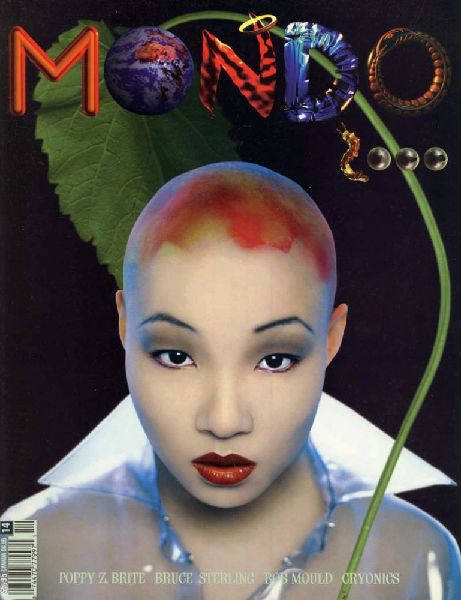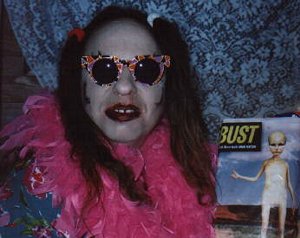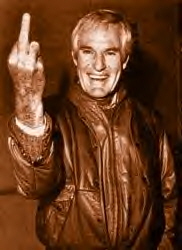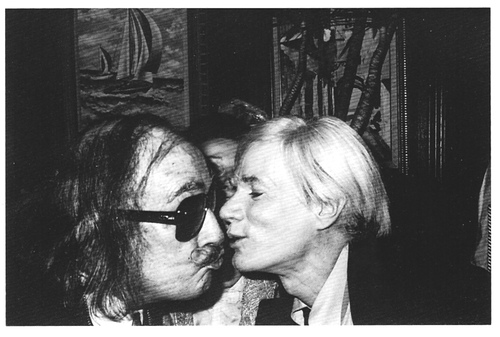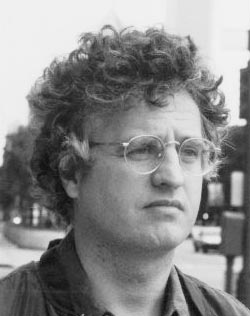
“We talked and tripped. I decided to know God at any price, but when I came down and found some 10 Chaos guys spread around in my living room snoring and shouted, I greeted them as God, but he was with so many! We also discussed the Silicon Brotherhood idea while sitting both in that bathtub.”
As I explore Mondo 2000 History, I find myself unreasonably surprised by my own recollections — particularly by the degree to which “new age” influences flowed through both the scene and the magazine.  My own exploration of this cultural and memetic milieu  is shaping up to be fairly critical, but in this commentary sent to me for use by the Mondo 2000 History Project, Dutch writer, publisher, and entrepreneur Luc Sala eloquently embraces Mondo as “a door to understanding and experiencing the convergence and integration of technology, new age, philosophy and art”… while also noting our distinctions from some of the more formal “spiritual” practitioners.  I’m always happy to have inspired anything… well, just about anything.
Luc sent us a long ramble… a mini-memoir for the project, which he has graciously consented to my publishing here.  I’m going to run it in two parts — today and Friday. I think it provides one of the many flavors of Mondoid reality.
R.U. Sirius
Mondo 2000 has been, for me, a door to understanding and experiencing the convergence and integration of technology, new age, philosophy and art. I believe the magazine and the scene were at the root of the development of the late twentieth century cyberculture and have helped bridge the gap between the more traditional new age (fairly conservatively focused on eastern traditions, health and body; somewhat negative and Luddite about technology) and the computer/information wave.
My involvement with the actual magazine was limited, I sponsored with money and was international distributor (paying in advance helped to print the magazine). My involvement with the people of and around Mondo was what was most important for me, those contacts opened a door into the world of cyberspace, cyberart, psychedelic (ontological) philosophy, design and counterculture. The Mondo scene was where one would meet the great alternative thinkers and writers. They were easy with their contacts and networking; opened many, many doors for me and I am very grateful for what I took home — not so much in material things, but in thinking for myself. Mondo inspired me to publish a similar magazine in Dutch, called Ego2000, and has been a source of contacts and new ideas for my activities in the nineties. Apart from writing and publishing. this encompassed my broadcast television station in Amsterdam. This Kleurnet channel (colored net) produced some 8000 television programs between 1995 and 2001, covering a wide range of subjects, many with a similar focus and taste as to what Mondo offered.
Mondo 2000 was a focal point where the counterculture, psychonauts and mind-researchers met, physically in Berkeley, and at various events in SF and elsewhere. They met in person, but also communicated via the then emerging email and budding internet communications of the times such as The Well. It united the greatest out-of-the box thinkers and change agents of the era, but was not a commercial success. Money to pay the printer had to be found every time. Lack of commercial talent and financial savvy hampered its development so that the newer Wired was able to capture the flag of the cyberculture. Wired was more of a hit, but remained more gadget-oriented and lacked the heart and zeal of the Mondo initiative. Funny enough, founding publishers Louis Rosetto and his partner Jane Metcalfe (after their Electric Word venture in Holland) contacted me in early 1990 to ask for funding for a new magazine in the US, which later became Wired (1991 trial, 1993 first issue). Jane was a great networker and organizer and I actually employed her for a while. She set up the seminal September VR-party in my house in Hilversum, near Amsterdam. I always considered Wired as overly commercial and not so ethical and was proven right when Wired tried to go public and failed because their data were not very honest, to say the least. While many contributors wrote for both magazines, the Wired–Mondo dichotomy; the difference in focus taught me a lot about the soul, the root energy of a venture, how the initial thrust kind of shaped its future. Wired in a sense was a cheap market oriented venture, it lacked the quality and integrity of the Mondo format.
In the early Eighties (1982) I started my computer magazine publishing company, after working as a launch editor and roving reporter for Pat McGovern of IDC/IDG, before that being employed by Fasson, Bruynzeel and Philips. As a then new journalist (I never trained as such) I travelled extensively to the USA, as the rise of the home computer (Commodore, MSX, Apple, PC) was partly a European thing with English makers like Sinclair, but obviously the USA was the motherlode for computernews. I went to shows like the NCC, the Comdex and the CES shows, often in Las Vegas, where I hooked up with the Californian crowd of computer journalists, afficionado’s and hobbyists. Those were exciting years, the computer spread from the highbrow DEC/IBM scene to the home, hobbyists became involved, the Commodore 64 opened a new world of low level ICT. I rode that wave with magazines, end-user shows (PC Dumpdag), books and even a retail operation. I was familiar with computers already during my studies (Physics at Delft University and Economics in Rotterdam), in my early career followed trainings in Industrial Engineering and was groomed by Philips for an executive commercial position in telecom in a year-long worldwide training program. When the personal computer emerged, I jumped in with a 16 KB Philips P2000 unit I used for my first books about home-computers, computer games and programming and then gradually developed my publishing and writing activities in telecom, the home computer field and later in more general ICT. I am happy I went through the rigorous mathematical and physics programs at university, because it taught me to think straight and systematic; this being in line with the slight Asperger syndrom behaviour I sometimes display. Apart from that I have always read extensively and my journalistic and media skills were acquired and learned by doing and supported by some guts, I was always in for a new venture.
Homebrew computers
In my travels for the computer press I met people like Lee Felsenstein, Jan Lewis, Mary Eisenhart (Microtimes), and of course Allan Lundell, Amara Angelica, Saint Silicon (Jeffrey Armstrong) Dusty Parks and friends. We were hanging out together; meeting at the computer shows in the press rooms. We joined the insider parties at these events with what then were budding entrepreneurs like Gates and Philippe Kahn (Borland), and opinion leaders like John Dvorak and Jerry Pournelle. I felt part of the new wave of ICT for the masses, but as an insider. I wasn’t only a journalist and writer, but invested a bit, started trading computers and basically used my publications to get in touch with interesting people. This is something I have always done, even my Kleurnet TV station was a kind of front, a mousetrap to catch the inspiring and interesting ones, the change-agents, the mavericks.
However, in those days it was all very straight; computers, ICT, business, the alternative wasn’t on my mind, but I was connected. This all changed in 1989. I got in touch with new age thinking, had some deep and life-changing personal mystical experiences and opened up to the alternative side of computers, like brain machines, mindware (Bruce Eisner’s focus) and saw the much broader horizon opening with multimedia, pictures, video. There were visits to Xerox Parc, contacts with fringe scientists, hackers, game-developers… I realized that the days of alphanumeric number-crunching were over. Another notion that dawned upon me then was that data and information are not the same; “a bit is only information if it bytes†was the keyphrase I used and use to make that clear.
GHC
Then around the first big Hacker Conference august 1989 in Amsterdam (Hack-Tic/Paradiso), I was approached by my friend Allan Lundell (his book Virus was just out… and the famous Captain Crunch — John Draper — was there too) who proposed to me that I support a new magazine which was to be called Mondo 2000 and showed me a mockup. It looked fantastic, desktop publishing really applied to creative publishing, in color, with visual effects that were, at that time, revolution in action. At the closing day of this conference (The Galactic Hacker Conference/ICATA) we had a party at my house in Hilversum (25 km from Amsterdam), where many showed up. The hacker folks, the Chaos Club people with Wau Holland, the local hack and Digitale Stad luminaries like Rop Gonggrijp and Caroline Nevejan came. It was a nice party, that cemented many connections made at the hacker conference, which was in itself a major networking node in the pre-internet times (we had some email, but no web then). Allan and I dropped acid, sitting in the bathtub of my house. We talked and tripped. I decided to know God at any price, but when I came down and found some 10 Chaos guys spread around in my living room snoring and shouted, I greeted them as God, but he was with so many! We also discussed the Silicon Brotherhood idea while sitting both in that bathtub. Allan has some video from that party.
Locally this GHC stemmed from Hack-Tic and resulted in what later became XS4all and De Digitale Stad, but I personally had little empathy for what then was labeled as technoanarchistic hacking and focused myself on the USA and international side of things. However, this GHP brought together ‘the crucial network’ as Caroline Nevejan describes this and certainly influenced the cyberculture and cyber-counterculture. She, in a way, sees this as a consciously staged and orchestrated process, bridging the incommensurability (see 1962 Thomas Kuhn ‘The Structure of Scientific Revolutions’) between participants. I tend to see it more as an autoconspiracy (again a notion Barlow inspired), an energetic exchange that fits the times and the place, and kind of inevitable happens. Maybe this is because I always more liked less staged parties and the mixing of people, ideas and disciplines that can then happen, more the be-in philosophy (Michael Bowen 1967). We come together because we had to, and for an outsider this might look like a conspiracy, but it is more a play. There usually is a spielmeister or facilitator, who sets the stage, but does not know or plan the outcome. This all of course has to do with my understanding of time, future and energy and how things come to pass,. The malleability of reality and the laws of nature is a major issue in my further work and development.
These events, like the GHP and the 1990 Linz Ars Electronica were pivotal events. The people that mattered in what later was coined the new edge movement met and started to make it happen.
Mondo
As a result of meeting the Mondo people in Amsterdam and my promise to help them out financially, somewhat later in 1989 I went to the USA, partly because of my regular visits to computer shows and Silicon valley as a journalist/entrepreneur, but also to renew contact with Lundell and the Mondo crowd. That late summer many things happened in my life. I discovered spirituality and had some amazing mystical experiences, got in touch with the Esalen new age crowd and began to see computers in a much wider and more spiritual context. Before, I was already interested in what computers could do for psychology, like with brainmachines and even started a small shop called Egosoft. There I was selling all kind of mind-enhancing devices, the early smart drugs, and all kinds of brain-tools, hypnotic audio, isolation tanks, even some magic mushrooms — stuff that was totally legal then. But in the late summer of 1989, there came the interest in the more esoteric, even the mystical aspects, like in techno-paganistic work of Marc Pesce (the VRML guy) and how information is a dimension in itself, related to consciousness. These thoughts and notions have kept me busy ’til today, with Infotheism and the legality of Cyberspace still on my mind. Information in that sense is a path, the Silicon path, as in the Silicon Brotherhood Creed from 1989 (see adendum).
In the USofA
In the USA that autumn I got more in touch with the Mondo house and the Mondo crowd, even stayed there for some time. I wasn’t so much working on the magazine but just being helpful, paying for the first Apple Postscript laserprinter, for food and many things — as cash was rather scarce in those days. R.U. Sirius did have the most amazing collection of weird psychedelics.
It was an old house, above a creek and fairly complex of structure, with offices and rooms tucked away here and there. Alison Kennedy aka Queen Mu and Ken aka R.U. Sirius were living there. Jas Morgan was running around and the whole house was full of rubble, books, stuff, ideas, notes and half-worked articles. Mu and R.U. then were in a strange quasi-relationship. There were lovers and would-be lovers (a guy kind of lived in a van outside); many guests and some people working on the magazine. One of them was Linda Murman, then with Allan Lundell, who did some admin and money chasing. I had a great time there, not doing much apart from sending editorial articles back to my magazine staff. I remember that as the place was messy, even filthy, with rubble everywhere, I tried to clean here and there.
One day I decided to clean out the big fridge in the kitchen, and kind of put aside or in the bin the weird little packages there that I thought were just old pieces of meat or something. This caused a panic, as there wasn’t only a bear’s penis, but also spider venom and a few other outlandish ingredients, related to Queen Mu’s work/hobby. Anyway, I met amazing people there, among them John Perry Barlow, whom I liked and had many and deep conversations with. He had an apartment on Potrero hill in SF, but his family was living in Wyoming. One day he went to visit them. I hitched a ride across the bay, and then our conversation was so animated, that I stayed with him (I could always take a train back was the idea) for the whole trip, some 15 hours through snow and ice, to his family house in Wyoming. I flew back after a nice meeting with his wife and kids. On my 40th birthday, the Mondo people, always in for a party, especially as I was paying for the food and drinks, threw a great birthday dinner for me. Timothy Leary, Barlow, Claudio Naranjo and his wife (Enneagram); the weird professor of Asian religions that Queen Mu was more or less married to (a great dinner entertainer), R.U. Sirius , Linda and some more.
There was a catch, however, as Mu, in her role as grand witch, had secretly decide to match/couple me to Linda. As I was not very experienced with psychedelics at that time, the kind of concoction they half-jokingly slipped me caught me by surprise. Before that summer I had never taken anything, only one toke of a marihuana cigarette when I was 16 or so.
Her recipe in a way worked, I ended up with Linda in bed and for the next few months that was it. She had a house in Boulder Creek, full with Allan’s stuff and took me there. As I had no car, I was kind of stranded for the week out there. I remember how I sifted through Lundell’s gear. He was a writer for electronic and AV magazines, not a great organizer, but assembled the most extensive collection of video gear one could imagine, most lying around in the Boulder Creek house on the hill or stashed in a shed outside. I cleaned out a lot of rubble, read, and watched video’s (no web then!). Sometime in the spring of 1990 I decided to go back to Holland and pick up my activities as publisher. My company kind of ran itself, while away, I just wrote articles and editorials and emailed (complicated procedure in those days with modems and 12kbps connections) them, for the computer magazines we produced, In those days there were magazines for specific machines like Commodore, Atari, PC-DOS, MSX and one about general computer news.
I was (at that time and still) an outspoken and somewhat obnoxious journalist, publisher and entrepreneur and I made money in ICT, and therefore I was a bit the “enemy†of the alternativo’s in the Dutch hacker scene. When the hackers sold out for big money a few years later (Xs4all), I felt they had betrayed their original creed. I however always believed their stance was worth protecting, and the Silicon Brotherhood Creed at the end of my Virtual Reality book (written in 1990, but this creed evolved in and from meeting with Lundell in 1989) acknowledged the importance of the deviant, the alternative, independent hacker).
Barlow was, in those days, a good friend and inspiration. He spent quite some time in SF. We travelled and tripped together, he got me backstage at the Grateful Dead new years concert, we visited trade shows and discussed the world, copyrights, God and psychedelics. His thinking inspired me a lot. I had used so many of his ideas and visions in my VR book, that I decided to put his name on the cover too. We differed in opinion in some ways. I never sided with his belief that copyrights don’t matter, that information should be free. His Cyberspace Independence Declaration/Manifesto was, in the context of his EFF work, a great statement and has been very influential; one of the few articles that really address the need for clear cyberspace rights and laws. It was, at the same time, somewhat naive, expressing a belief in the power of information and freedom that didn’t reckon with the traditions and forces concerning copyrights and the fear of institutions and governments for total freedom. I think Barlow was also inspired by Leary’s Declaration of Evolution (1968). The whole subject of cyberspace rights, legislature and freedom has been the subject of many articles I wrote in Dutch, also in the context of Infotheism and my personal notion of evolution as “a remembrance of the future” and what DNA is (an antenna into the future).
Sacramento 3220
The San Francisco scene in those days had (for me) two poles. One was Henry Dakin’s outfit on Sacramento 3220 (Henry’s Playhouse full with nonprofits and a secret Apple multimedia lab, the SF-Moscow Teleport, Jack Sarfatti and, later, Faustin Bray). The other was the Mondo House, up the hill a bit in Berkeley. Henry was a humble and softspoken millionaire, heir to the Dakin Toys fortune but fascinated by the alternative; be it waterbirth, East-west bridging, dolphins, new physics (Jack Sarfatti), Damanhur or psychedelics. He facilitated so many and was so helpful in organizing, promoting and financing the new, the different, the small and great innovators, I always liked him and his gentle approach. He was easy, slept in the back of my Egosoft new-edge shop in Amsterdam. He was an inspiration for me and many.
The Mondo house, with Queen Mu in charge and at the purse (and the editing!), was a different story. More egocentric, Mondo wasn’t about helping the world. It was an ego-statement by what my kids called catch-up hippies, flippo’s obsessed with the new, the different, who saw the potential of the new technology, as a mind changing and world changing tool. The spirituality that Henry Dakin lived was part of the Mondo culture too, but more as a tool, an experience, as part of the psychedelic awareness, the transcendental in action. Of course the house was full with esoteric art and books. All present were very well read. With people like Claudio Naranjo (enneagram), Barlow and Jaron Lanier around, philosophy and spirituality were part of the daily smorgasboard of discussions and exchanges, but not in a formal way. Although all had some deeper understanding and awareness of the mystical, the transcendental or deep contemplative was not on the agenda. Many had (had) contacts with Alan Watts or John Perry and the beat-generation poets like Ginsberg were not far off, but Mondo was more worldly than that. It made connections with the New Physics crowd via Nick Herbert (and Fred Wolf); dabbled in whatever was new in arts and music, but kind of stayed away from the health scene, the new age body work, Gaia folks and soul searching. But there was enough; the connections from Mondo with what was happening in the Bay area and beyond were fascinating. I really laid the foundation of my network there, which became the basis for my later work (writing, television, esoteric studies) and inspires me till today.
Counterculture
Before Lundell and friends made me aware of Mondo and got me involved, I was familiar with the technological side of things, the ICT industry and its outgrowth into brain machines, mind technology, but was not really hip to the general counterculture of those days. I was more a new age person with an ICT interest. Of course when I got to the Mondo house, I caught up. I have seen and read the earlier publications that R.U. was involved with — High Frontiers and Reality Hackers, but those were more traditional in appearance and layout. It was Mondo (and of course Bart Nagel and Heide Foley who made that jump in layout perspective happen) that really opened up to PostScript and the integrated layout possibilities that so markedly made Mondo 2000 a new wave in publishing.
When the Mondo people asked for support, I donated money to help print the first issue, as did John Perry Barlow and I also subsequently helped out here and there with some funds and became international distributor, not with much success. It came down to preordering and prepaying for some 800 issues (and that helped to get it printed anyway) every run, and having them shipped to some distributors in the Netherland and England. However, I never made money out of Mondo and ended up with serious stacks of Mondo’s, still in my cellars.
As R.U. was not only a keen observer and gifted writer, he also supplied all kinds of things to the Bay area cognoscenti and therefore had a real interesting network. Psychedelics were the not so secret but illicit link between the various subworlds of art, literature, music, new age and technology. Morgan Russell, R.U., Queen Mu, St. Jude (Jude Milhon/Hippie) were all broadly interested, but in different directions, with different networks and it was this convergence that was the hallmark of Mondo. They covered the whole gamut of alternativity, with a distinct “highness” underlying the meetings, events and discussions.
As this was the Bay Area and Silicon Valley was close, the link with the computer industry was easy and logical, There was the money and the excitement, in those days everybody looked at the new possibilities, whether it was in music with synthesizers; in broadcasting with digital media; in entertainment with the emerging computer games — and virtual reality was definitely the magic potion that would free us from the limitations of space and time, the ultimate trip, the electronic drug. Most of the people involved had a sixties background, although there were also the catch-up hippies like myself, who missed out on but were fascinated by the likes of Leary and the Zeitgeist of the sixties.
Part 2 will be published Friday, 3/30
Adendum
The Silicon Br/otherhood :
` We acknowledge the Silicon Path ‘
By Luc Sala and Allan Lundell
Hilversum, August 14, 1989
The computer and information technology, with the word Silicon as its main symbol, is one of the identifiers of the 20th century. This has challenged some to explore its possibilities beyond the mere superficial, utilitarian aspects of it. In arts, media, psychology, Artificial intelligence, consciousness projects, religion and creative crime, new applications are discovered and new interactions mapped. As has happenend in the history mathematics, the quabala, martial arts, building technology etc., such powerful new knowledge is first applied to the relatively mundane fields of economics, warfare and the suppression of people before one acknowlegdes and then explores the transcendental possibilities.
All through the ages people have concentrated on parts of the reality to gain access to the greater or even ultimate reality in themselves and the perennial wisdom of our species and the earth, our Silicon Mother Goddess.
The computer offers us new, and at the same time, age-old, possibilities of concentration and expansion, of communication and isolation, ego-discovery and letting go, that are largely untapped. Those who are now so deeply involved in the computer are, even unconsciously, part of a new tradition, the Silicon Path.
Now we, the initiators, explorers, guardians and even exploiters of the Silicon awareness revolution are concerned about its uses and abuses, and above all, acknowlegde its potential for growing awareness and human transcedence. We owe today’s hackers and whiz- kids, and ourselves, the opportunity to follow the Silicon Path, becoming the magi(cians) and mystics of our times. If the computer is nothing but another way to get in touch with the ultimate reality (and what else could it be), it needs some `small’ br/others to safeguard that path.

